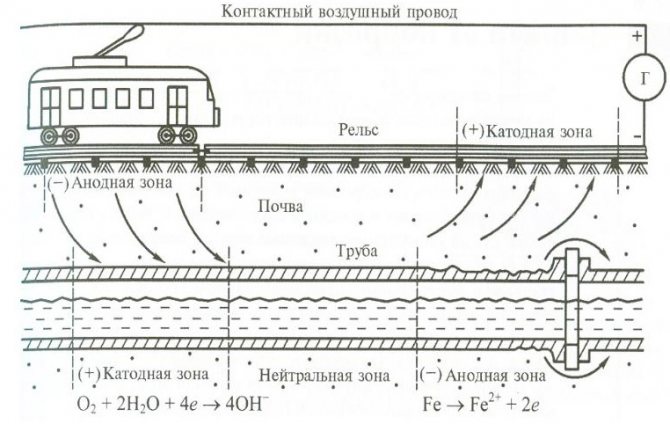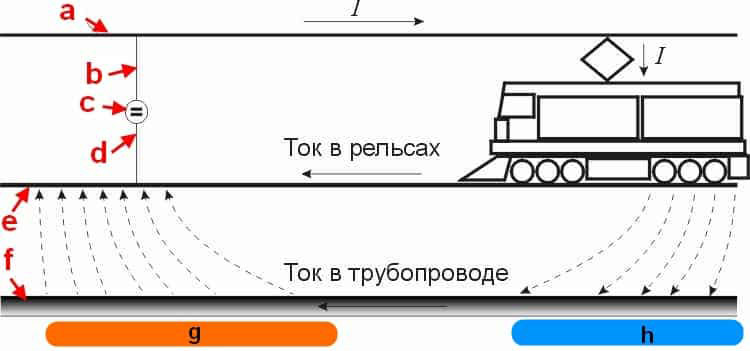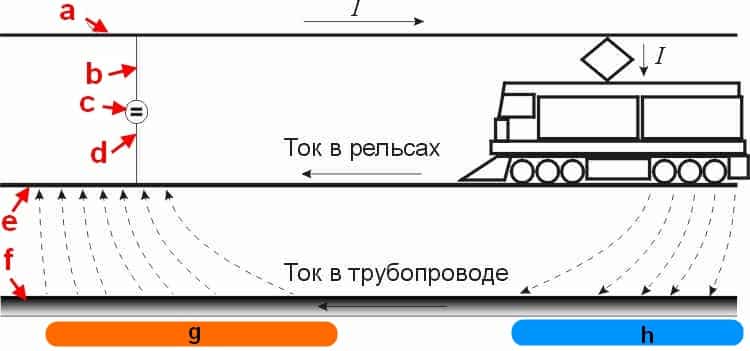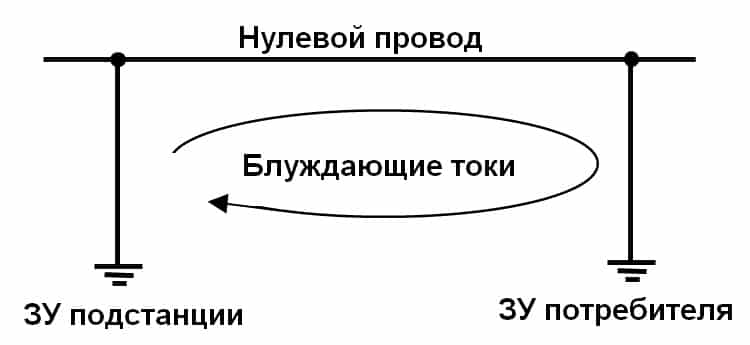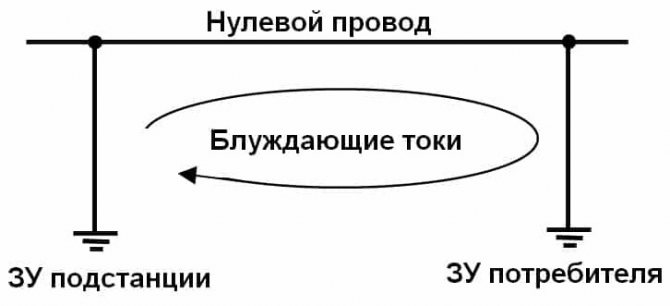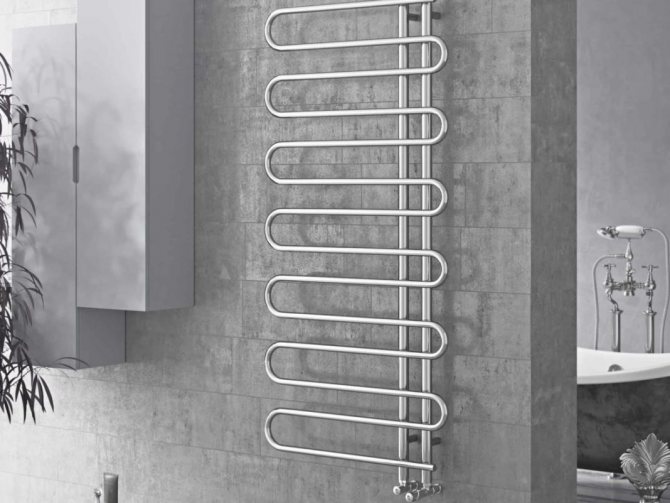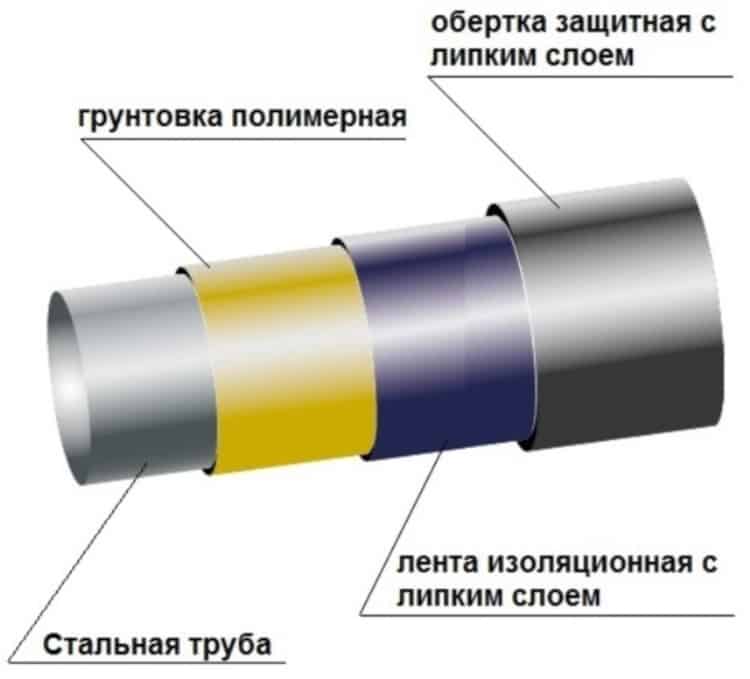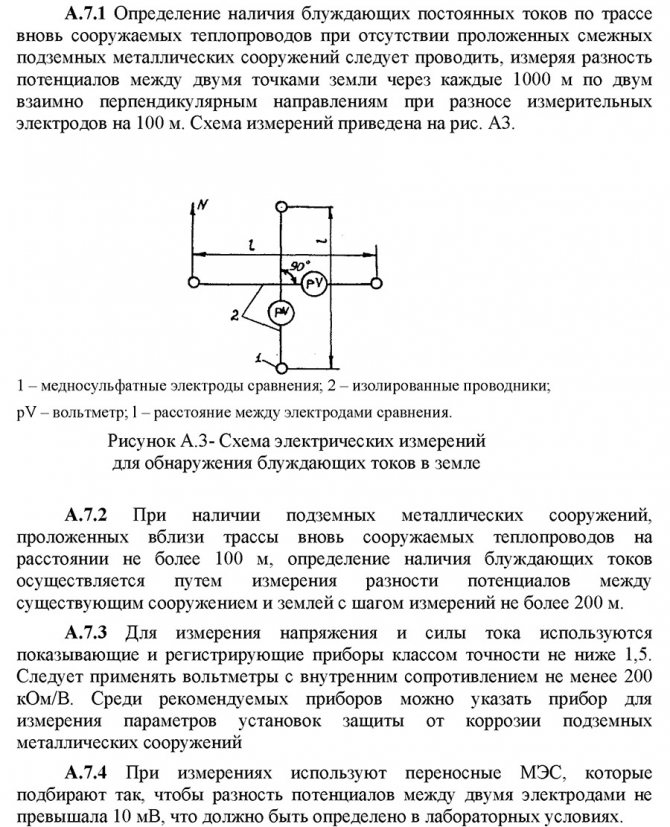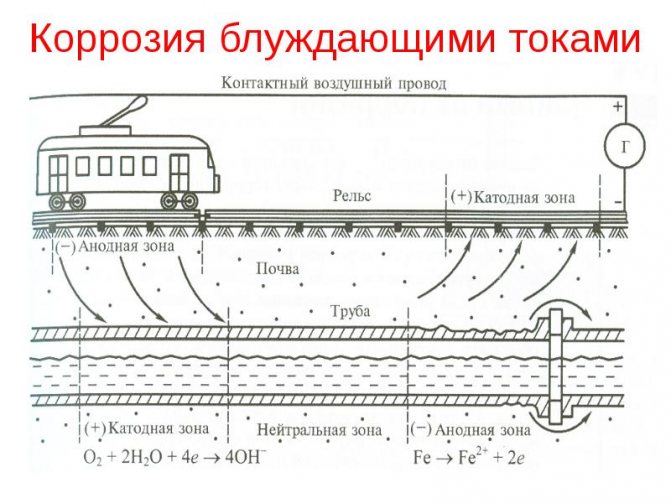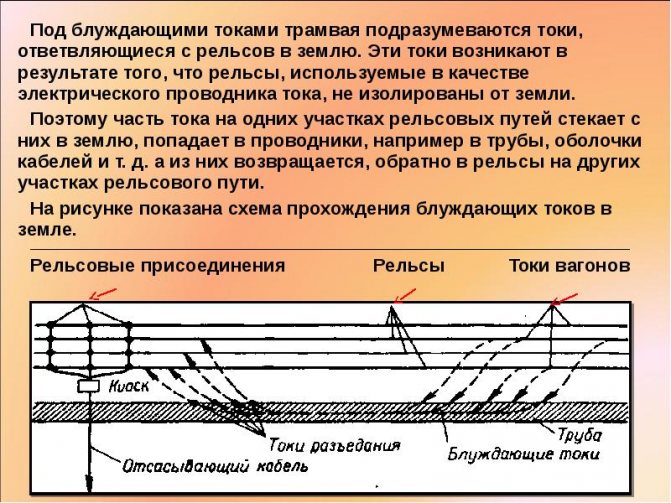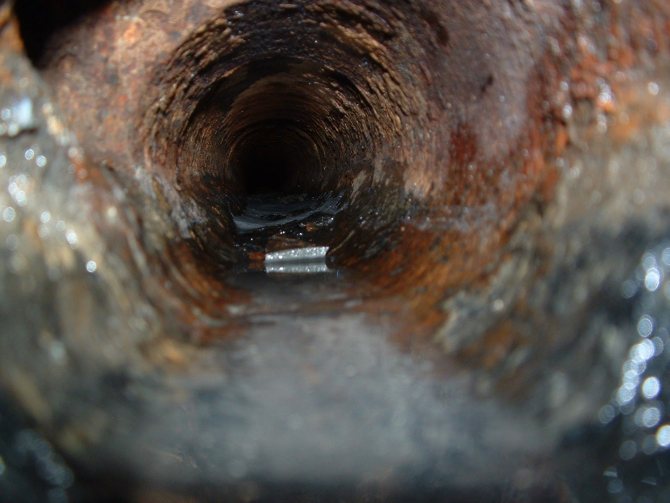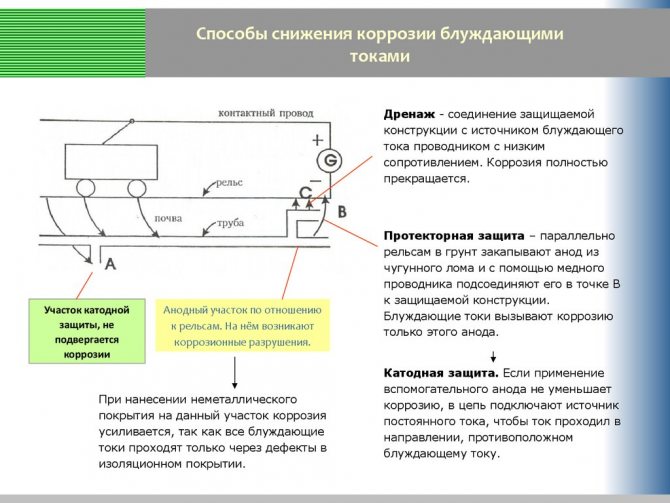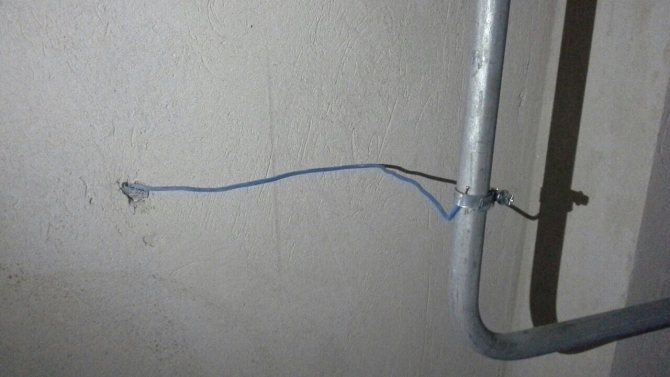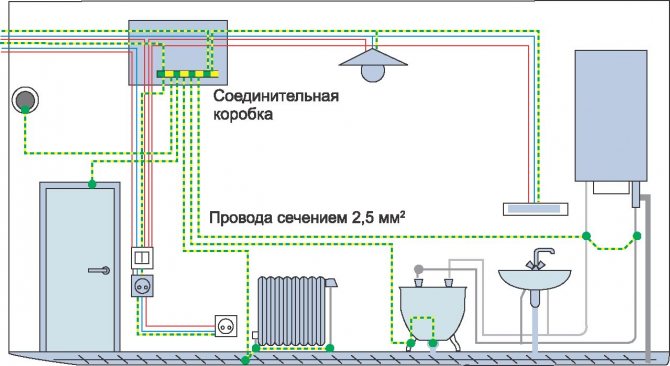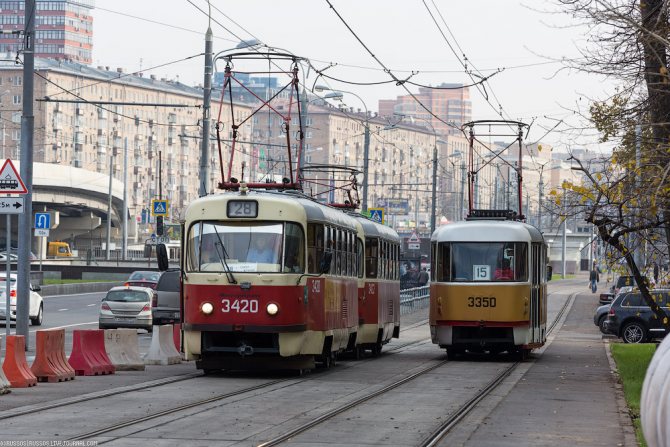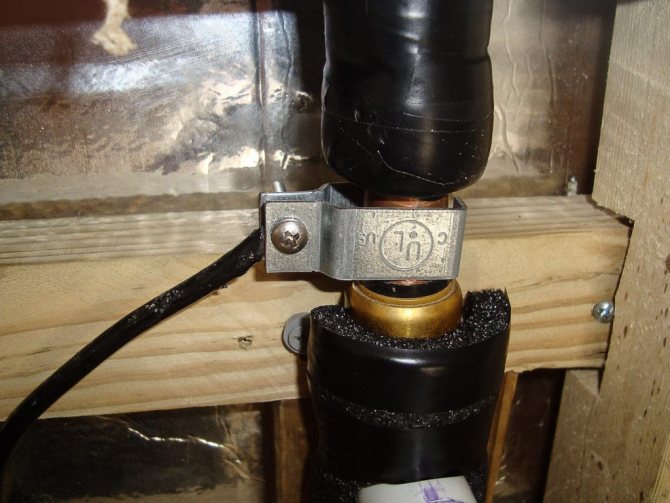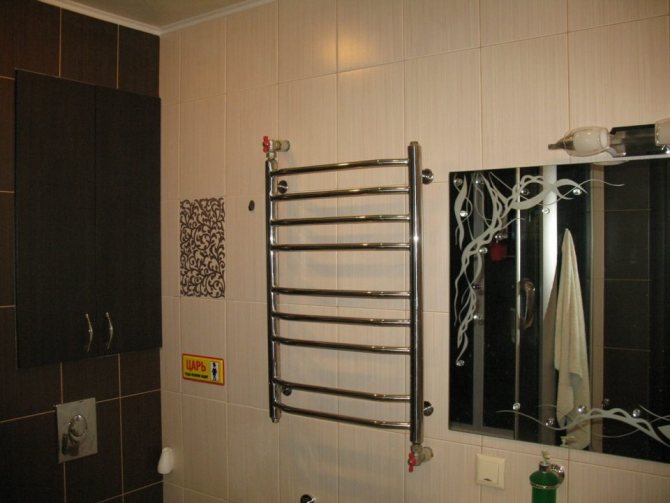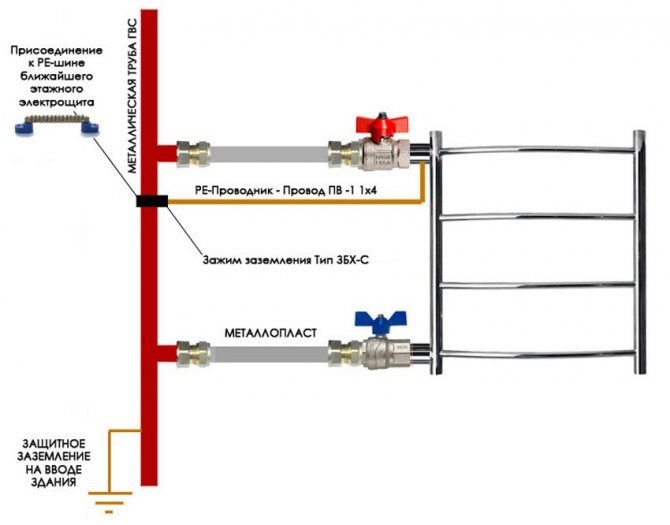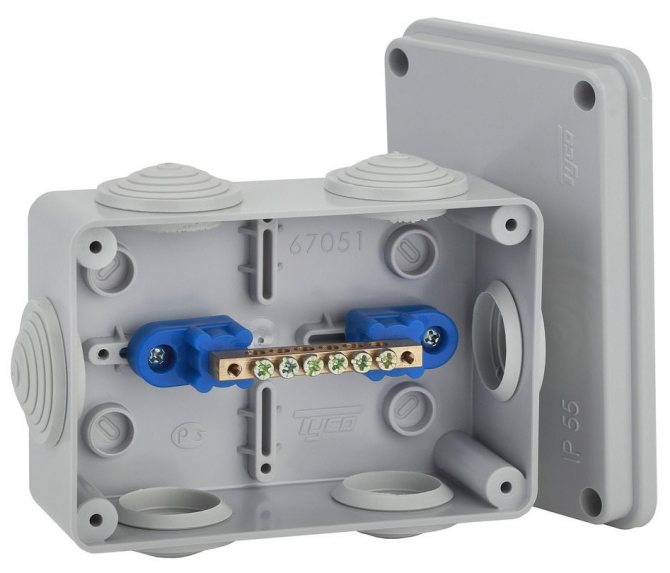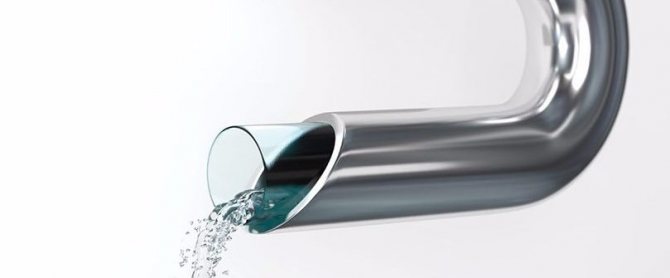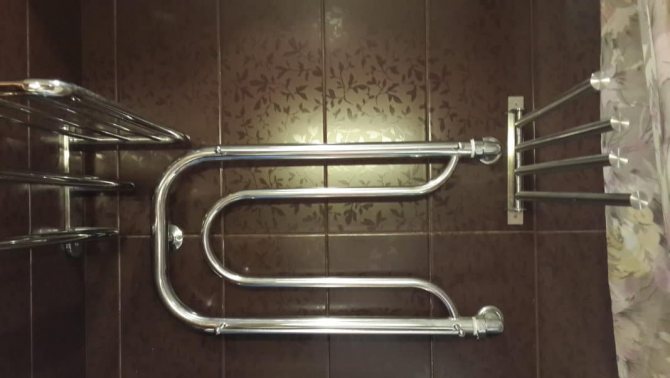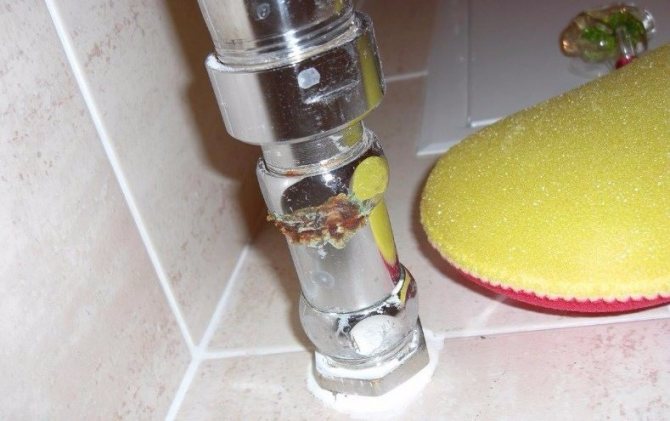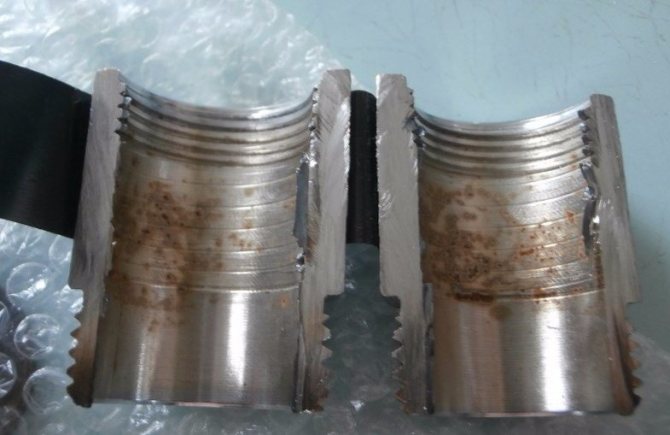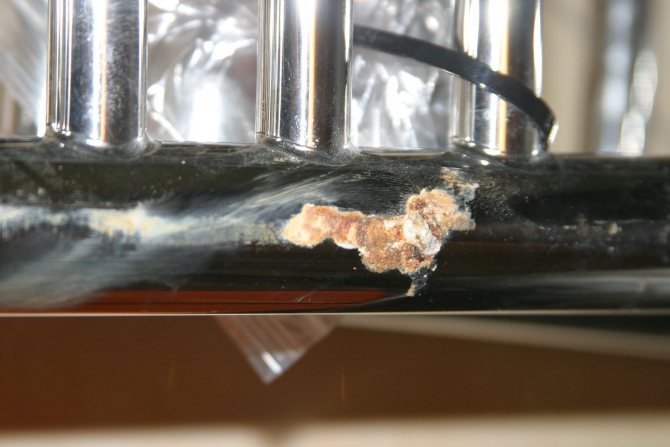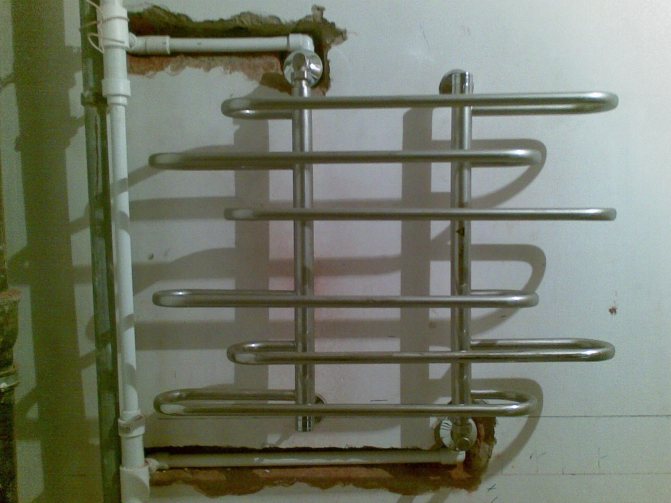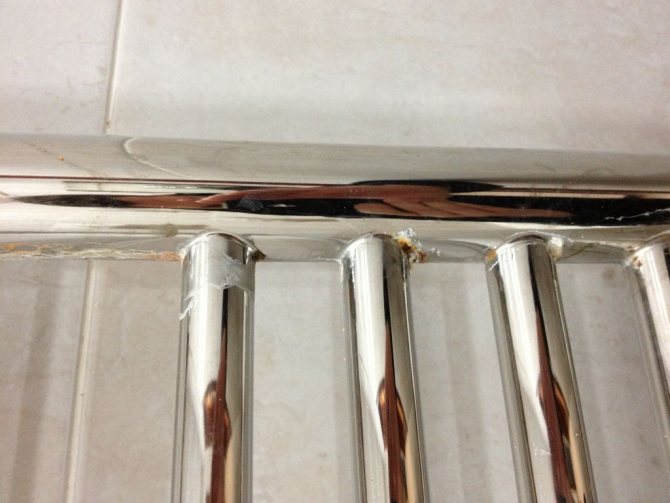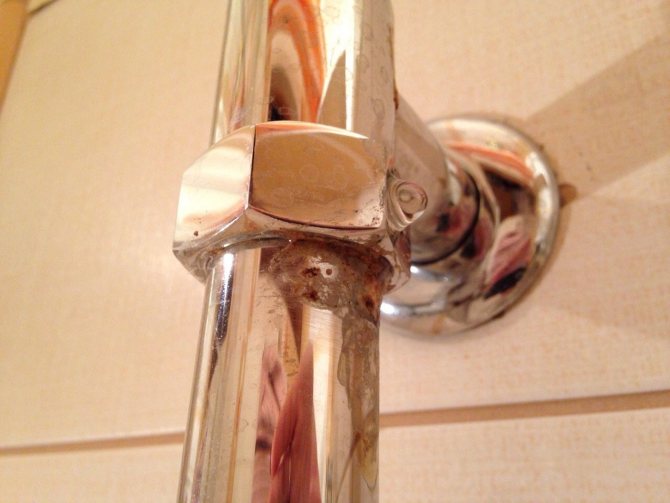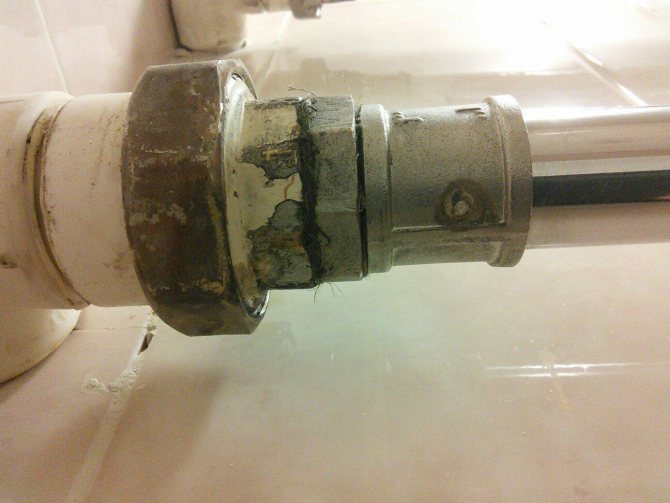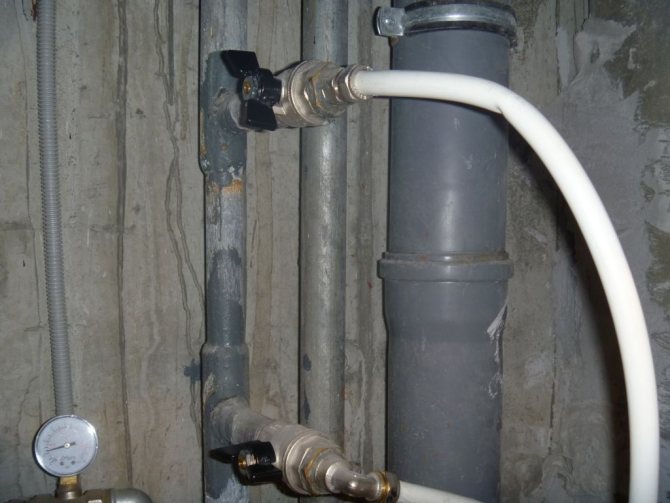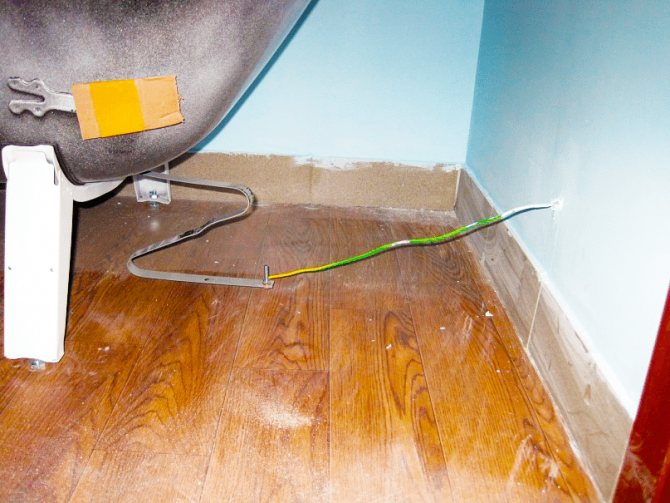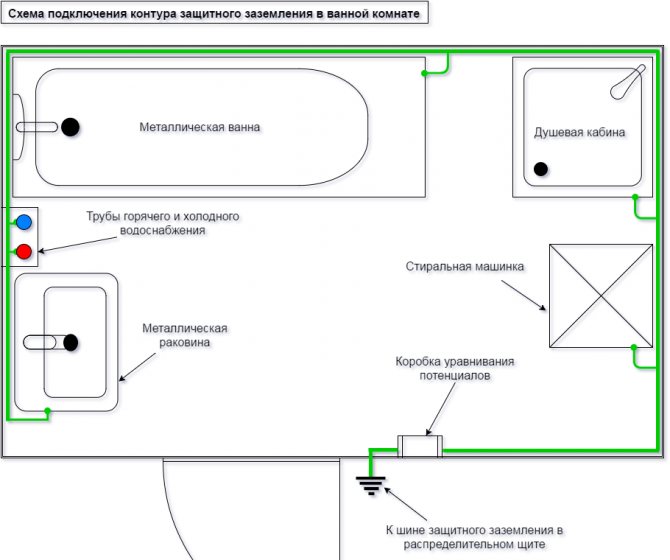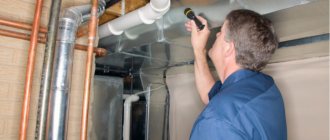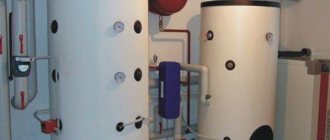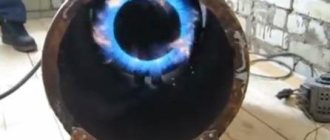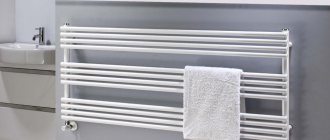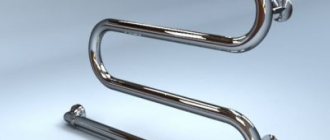Over the past 10-20 years, many megacities have seen a sharp decline in the service life of underground metal structures (hot and cold water pipelines, heating systems, etc.). After a series of examinations, it was found that the main cause of metal destruction is electrochemical corrosion, which is caused by stray currents. From this article you will learn about the nature of this phenomenon, as well as get an idea of how to protect underground structures and utilities from galvanic corrosion.
What you need to know about stray currents?
Any metal objects in water or in the ground, regardless of their purpose, are susceptible to corrosion, which can be:
Electroplating
It is related to the reaction between different metals. So, for example, a galvanic pair leading to destruction can be created by steel and brass or steel and aluminum. The reaction begins as soon as a "duet" of different metals is formed and the resulting unit comes into contact with the electrolyte. In a situation with a heated towel rail, the role of the electrolyte is played by ordinary tap water, which reacts with metals due to the content of a significant amount of minerals (the same reaction will occur with sea water rich in salt). And the higher the water temperature, the more active is the process of metal destruction. That is why the hulls of ships sailing in the warm southern seas wear out faster than ships in the northern fleet.
Corrosion of stray currents
This process is caused by the so-called stray currents that occur in the earth if it acts as a conductive medium. In this case, not only metal objects that are completely in the ground, but also those that only come into contact with it, are subjected to a destructive effect. But where do these currents come from? It's simple: in most cases, their appearance is the result of leaks from power lines. This group also includes the so-called zero currents present in ungrounded structures.
The reasons
Many who have installed a heated towel rail at home have encountered the problem of electrical corrosion of the device. One of the main causes of corrosion is stray currents. To cope with this problem, it is enough to provide a strong metal connection between the pipes of the connection riser and the pipes of the heated towel rail. That is, it is necessary to ground the pipes.
Another cause of corrosion can be water. But not in terms of its chemical composition, which will adversely affect the condition of the pipes, but the fact is that the water, when circulating through the pipes, rubs against them, thereby generating a certain amount of current, which can also lead to corrosion.
Another factor causing stray currents in a heated towel rail can be an unscrupulous neighbor who, in order to save his day, put a magnet on the water meter and connected to the heating system, now the cubic meter of water goes in the opposite direction, currents accumulate in your heated towel rail.
First signs of corrosion
You can determine that your heated towel rail has become a "victim" of corrosive processes by the appearance of the equipment. The first signs of metal destruction are:
- swelling of the decorative layer (paint) - first this occurs at the joints and on the sharp edges of the structure;
- the appearance on the affected surface of a noticeable whitish plaque resembling a fine powder;
- the formation of small dents and depressions in the damaged areas - it seems that the metal has been eaten by a bug.
Minor damage is usually the result of galvanic corrosion caused by electrical potential differences between dissimilar metals, one of which acts as the cathode and the other as the anode. And if we add wandering currents to this, the destruction will be much more serious.
The need for corrosion protection
Protection of metal from influences that have a destructive effect on its surface is one of the main tasks facing those people who work with mechanisms, aggregates and machines, sea vessels and construction processes.
The more actively a device or part is used, the more chances it has to be subjected to the destructive effects of atmospheric conditions and liquids that have to be encountered during operation. Many branches of science and industrial production are working on the protection of metal from corrosion, but the main methods remain unchanged, and consist in the creation of protective coatings:
- metal;
- non-metallic;
- chemical.
We suggest that you familiarize yourself with the Connection diagram of a flow-through and storage boiler in an apartment or a private house., Online calculator, converter
Non-metallic coatings are created using organic and inorganic compounds, their principle of action is quite effective and differs from other types of protection. To create non-metallic protection in industrial and construction production, paints and varnishes, concrete and bitumen and high-molecular compounds are used, especially actively taken into service in recent years, when polymer chemistry has reached great heights.
Chemistry has contributed to the creation of protective coatings by methods:
- oxidation (creating a protective film on the metal using oxide films);
- phosphating (phosphate films);
- nitriding (saturation of the steel surface with nitrogen);
- cementation (compounds with carbon);
- bluing (compounds with organic substances);
- changes in the composition of the metal by introducing anti-corrosion additives into it);
- modification of the corrosive environment by introducing inhibitors that affect it.
Electrochemical corrosion protection is the reverse process of electrochemical corrosion. Depending on the displacement of the metal potential in the positive or negative direction, anodic and cathodic protection are distinguished. By connecting a protector or a direct current source to a metal product, cathodic polarization is created on the metal surface, which prevents the destruction of the metal through the anode.
Electrochemical protection methods consist of two options:
- the metal coating is protected by another metal that has a more negative potential (that is, the protecting metal is less stable than the protected metal), and this is called an anodic coating;
- the coating is applied from a less active metal, and then it is and is called cathodic.
Anodic corrosion protection is, for example, galvanized iron. Until all the zinc from the protective layer is used up, the iron will be relatively safe.
Cathodic protection is nickel plating or copper plating. In this case, the destruction of the protective layer also leads to the destruction of the layer that it protects. Attaching a protector to protect the metal product is no different from the reaction in other cases. The protector acts as an anode, and what is under its protectorate remains intact, using the conditions created for it.
A little about the nature of stray currents and their danger
The reason for the appearance of stray currents acting on your heated towel rail is the potential difference between grounded structures.And in order to equalize the potentials, it is necessary to create a system in which all metal elements will be in contact with the neutral conductor in the existing input-distribution device.
Such a system will maximize the safety of the user (if you grasp the pipe and grounded equipment with your hand, you will not get a fatal discharge). And this is very important, because the greater the potential difference, the more serious danger threatens a person. For example:
- If this value is 4 or 6V, you may receive a 5mA shock. It will be sensitive, but not fatal.
- If its strength is 50 mA, cardiac fibrillation may develop.
- And when the human body is exposed to a current of 100 mA, death occurs.
But there are cases when even a small potential difference in 4B became the cause of death.
Formation process
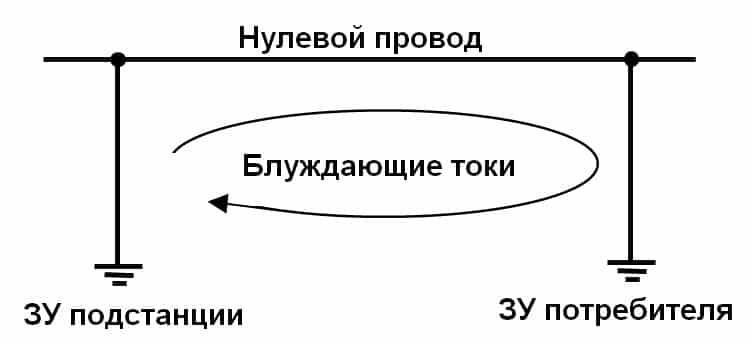
How they are formed
Stray currents are caused by a large number of equipment operating on electrical charge, as a result, the following elements are potential sources:
- the presence of a memory in such objects as substations, overhead lines with a zero conductor, distributors;
- the emergence of activity as a result of the destruction of the insulating layer of wires carrying current in cables and overhead lines, where the neutral is isolated;
- the presence of a connecting technological link between the conductor and the soil in structures with a grounded neutral and rail vehicles driven by current.
The mechanism of occurrence of spontaneous discharges can be considered on the example of one of the above points.
One end of the neutral wire is connected to the storage device of the power plant, and the other is connected to the PEN bus of the energy consuming device, which is connected to the storage device. It follows that the potential difference of the electrical value between the terminals forms wandering currents, since energy will be transferred to the memory, which in turn will form a circuit.
In this case, the volume of losses does not have a large percentage, since it will follow the path of the smallest resistance, but a certain part will fall into the ground.
Energy leakage occurs in the same way in the case of damage to the insulation of the wiring.
At the same time, a constant uninterrupted leak does not take place, since its occurrence is signaled by the system and the site is automatically localized, and also, according to the standards, there is a certain period of time allotted for troubleshooting.
Important! According to statistics, the main places for the formation of electricity leakage and the formation of stray currents are in urban and suburban areas, where there is ground transportation that depends on the power grid.
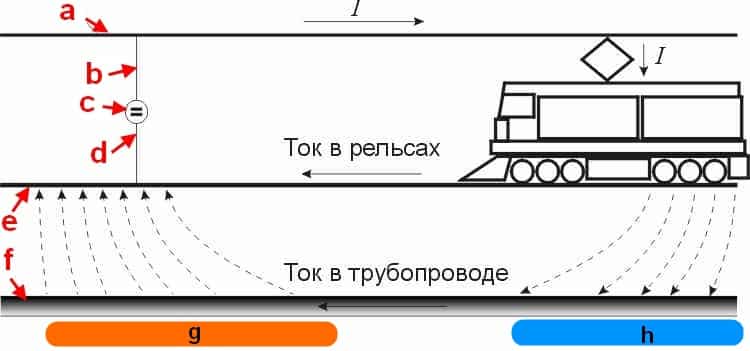

Currents on rails
When using urban electrified transport, voltage is supplied from the substation to the traction system, which switches to the rails and performs a reverse cycle. If the rails, as an iron base relative to the conductor, are not stable enough, this leads to the formation of stray currents in the soil, then any metal structure that appears in their path, for example, sanitary ware, acts as a conductor.
Important! This interaction occurs due to the fact that the current moving, chooses the path of least resistance, which is lower for the metal than that of the earth.
All this will lead to accelerated destruction of metal products.
Potential difference: causes of
But where does the potential difference come from, if the house is built taking into account all applicable norms? In theory, if the building rules are followed, there should be no potential difference. But in practice, it often happens that when assembling structures and engineering systems, welded joints are replaced with squeegees.Another common option is to integrate additional resistors or metal parts into the circuit. Both can cause a potential difference at opposite ends of the pipe and, accordingly, initiate metal corrosion.
Do not forget about the "conflict" between metal and plastic, which also plays an important role in the destruction of various peripheral devices (these include heated towel rails). Due to the fact that plastic pipes are often placed between stainless steel plumbing equipment and a metal riser (they are used to perform wiring around the apartment), the connection between these parts of the system is broken. And although the riser will be grounded in any case (in new high-rise buildings this is done through the equalization system, and in the houses of the old fund - through the ground loop located in the basement of the building), the potential difference is still formed. And when water moves through pipes, which demonstrates excellent conductivity, micro-friction also occurs, which is guaranteed to lead to the appearance of stray currents. And they, in turn, provoke corrosion. The circle is complete!
Do I need to ground the heated towel rail
First, you need to know that grounding (the construction of ground loops with your own hands) is not required if:
- 1. You are using an electric heated towel rail (such heated towel rails are usually equipped with special plugs in which there is a ground wire, all this is connected to the outlet, and the sockets themselves must already be connected to the ground loop).
- 2. You live in a private house or apartment and you have a separate heating system.
It is imperative to ground the heated towel rail in the following cases:
- 1. If your dryer is connected to the heating system with a reinforced plastic pipe. Inside the metal-plastic pipe there is aluminum, which conducts an electric current: at the joints where the fittings are located, the electrical circuit is broken. Accordingly, such a heated towel rail must be connected to the ground loop, or to a hot water riser.
- 2. If your hot water supply system is made of metal-plastic pipes.
All electric heated towel rails, as mentioned above, are connected to a grounded outlet, while such dryers have a ground wire with a separate contact on the plug. Since heated towel rails are usually installed in the bathroom, you should inspect the outlet to which it will be connected. Such a socket must be in a special protective case that prevents moisture from entering the socket itself.
There are 2 main ways to ground a heated towel rail:
- 1. Using the potential equalization system, which must be assembled with your own hands, then ground this system to the common ground of the electrical panel. This should be done if in a house or apartment instead of metal communications, communications made of polymers (metal-plastic pipes) are used.
- 2. Grounding the heated towel rail body pipe directly with an ordinary wire to a steel riser.
To realize the grounding of a heated towel rail in the second way, you first need to get a clamp, having previously removed all insulating materials from it. This clamp must have a terminal for connecting the wire. Then the clamp is attached to the pipe of the heated towel rail body.
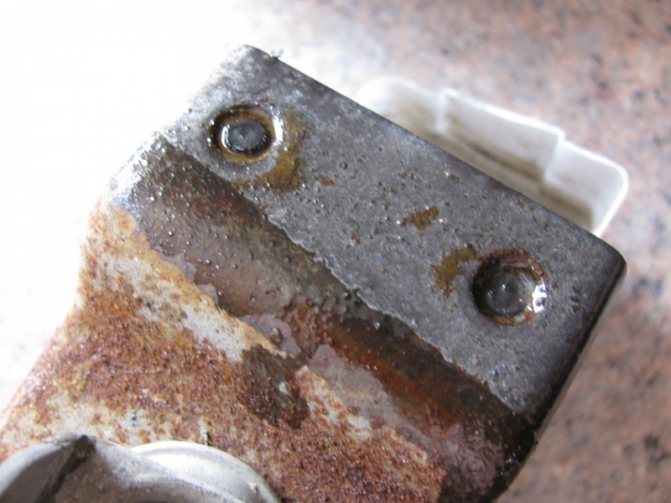

An ordinary copper wire is taken, which should have a cross section of 4 mm2. On one side, this wire is connected to the clamp terminal, its other end must be connected either to the ground of the electrical panel or to a steel riser. In addition, do not forget to connect to the ground loop and other devices in your bathroom.
| Such methods do not require a lot of time for their implementation, but in return you get a long and uninterrupted operation of the heated towel rail, and in the future the question “how to ground the heated towel rail” will not cause difficulties. |
After plastic pipes began to displace ordinary metal pipes, they began to ignore their grounding, mistakenly believing that a metal pipe and a metal-plastic pipe have the same conductivity. This is not true. There is no contact between the plastic pipe and aluminum: they are not connected.
Practice shows that 90 percent of heated towel rails begin to leak precisely when metal hot water supply systems are replaced with their plastic counterparts (for example, polypropylene). Old metal pipes are replaced with modern plastic pipes in order to reduce eddy currents. However, corrosion continues to manifest itself.
The first symptoms of electrical corrosion are the appearance of rust spots on the heated towel rail, and rust appears even on devices made of stainless steel. In general, all metal electrical products in contact with water are susceptible to both electrochemical and galvanic corrosion. Electrocorrosion occurs when stray currents are present.
When two different metals come into contact, one of which is more chemically active than the other, both metals react chemically. Pure water is a very poor conductor of electric current (dielectric), but due to the high concentration of various impurities, water turns into a kind of electrolyte.
Do not forget that temperature has a great influence on electrical conductivity: the higher the water temperature, the better it conducts electric current. This phenomenon is known as "galvanic corrosion", it is she who methodically makes the heated towel rail unusable.
Why didn’t such difficulties arise before?
Strange as it may sound, but the reason for the appearance of such a problem as the potential difference in engineering systems was progress. Namely, the widespread replacement of metal pipes with plastic ones. While the hot water supply, cold water supply and heating pipelines were completely metal, there were no difficulties. And there was no need to separately ground each radiator, mixer or heated towel rail - all pipes were grounded centrally in the basement of the house, in two places. And all metal appliances in bathrooms and toilets automatically became safe and protected from stray currents.
The transition to plastic changed everything: on the one hand, pipelines began to serve longer, and on the other hand, there was a need for additional protection of plumbing equipment. And here the point is not only in the pipes themselves, because in terms of conductivity, metal-plastic is close to traditional metal, but also in fittings - connecting elements. More precisely, in the materials from which they are made and which cannot provide electrical contact with the aluminum "core" of the metal-plastic pipe.
How does this phenomenon arise
Let us consider stray currents using the example of an electrified railway, under which a pipeline is laid.
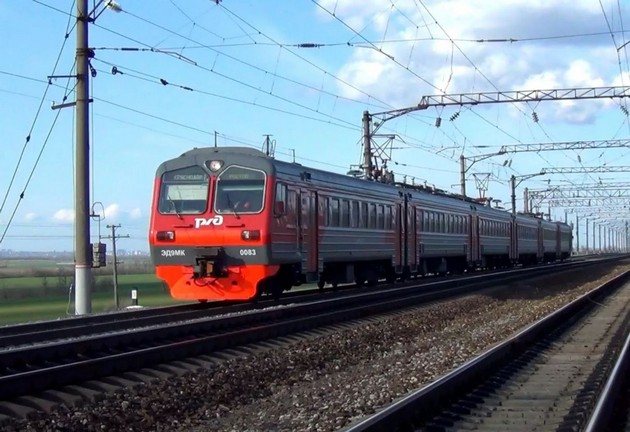

The electric train is powered by two contact lines: the phase wire is a contact network located on poles and suspended on massive insulators. And the zero "wire" is the rails. Traction substations are located along the entire route, which work according to the same principle: the zero potential is connected to the physical "ground" as a ground (grounding).
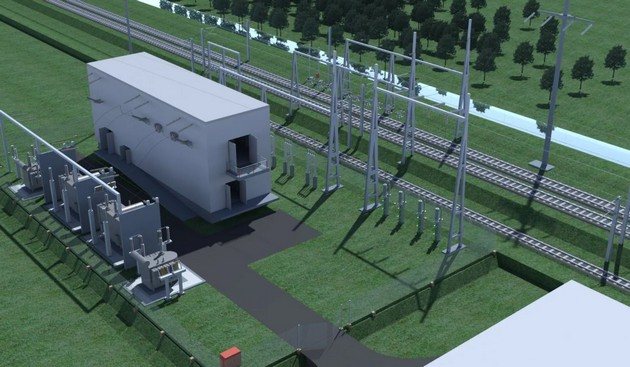

Since the working ground is in physical contact with the ground in any case, it is absolutely safe.
For information:
Do not confuse the passage of the virtual ground line with the step voltage that occurs due to a potential difference over a small area.The points of potential difference in a situation with stray currents are separated by hundreds of meters, or even kilometers.
A working electric current flows between the neutral and phase conductors (rails and contact wire). It normally occurs when the wheels are connected to the rails and the pantograph of an electric locomotive with a contact line. Since the rails are directly connected to the ground, it can be assumed that a potential equal to the potential of the neutral conductor also arises in the ground. If it is the same along the entire length of the track, no problem, this is a normal and safe situation. But the railway is seldom laid in a straight line. In addition, the electrical connection between the physical earth and the metal of the railway track is not always stable. It turns out that from one traction substation to a nearby one (several tens of kilometers), electric current can flow both along the rail and along the ground. That is, electrons can wander the shortest path.
We remember the curvature of the railway track, and we get the same wandering currents flowing in the soil.


And if communications are laid in this place (for example, a steel pipeline), then electrons flow along its walls (see illustration).
Where is the problem
By analogy with conventional electrical processes, an electrochemical reaction occurs. The wandering current tends to follow the path of least resistance (we understand that the ground, in comparison with a metal pipe, is the worst conductor). In the place where the conductivity between the rails and the pipeline is the highest (wet ground, ferrous soil, and other reasons), a so-called cathode zone arises from the point of view of the pipeline. The electric current seems to "flow" into the pipe. It is not dangerous yet: the pipeline is located in the ground, there is no potential difference, water under a voltage of 3000 volts will not flow from your tap.
Having passed through the pipe to a favorable place of flow into the rails, the electrons rush along the ground towards the "regular" conductor. An anode zone appears, the electric current "flows" from the pipe, grabbing metal particles (at the molecular level).
According to all the laws of the course of electrochemical processes, corrosion is intensively developing in this area. Plumbers are perplexed: the pipe is made of high-quality steel, has undergone all possible anti-corrosion treatments, laid in accordance with technical conditions, the service life is at least 50 years. And suddenly a breakthrough and a rusted hole the size of a palm. And all this in just a couple of years. Moreover, any metal is subject to electrochemical corrosion, be it steel, copper or aluminum.
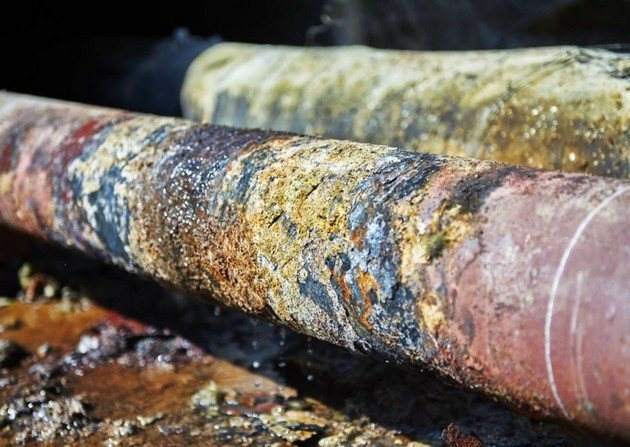

There is no connection with soil moisture, except that stray currents choose a "wet place" for the formation of the anodic and cathodic zones. This is a terrible dream of the emergency crews of the water utility. If projects are not coordinated between sectoral departments, the problem becomes uncontrollable.
Side effect that aggravates losses
Opposite the cathode zone of the "victim", that is, the pipeline, there is an anode zone of the rail track. This is logical: if an electric current enters somewhere, it must come out from somewhere, or rather flow out. This is the closest place in terms of the electrical conductivity of the soil where the rail has electrical contact with the physical earth (ground). At this point, similar electrochemical destruction of the railroad track metal occurs. But this is already a problem related to the safety of people.
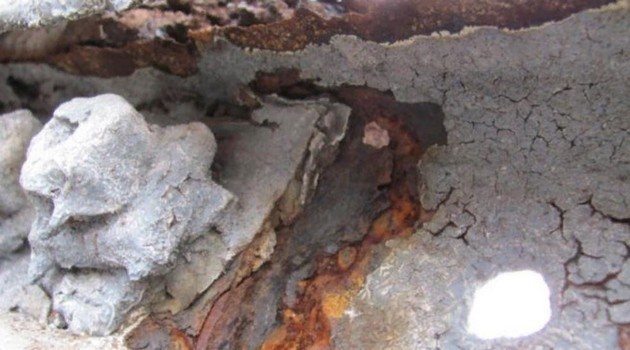

By the way, this situation is typical not only for main railways and pipelines. And they are not always laid parallel to each other. But in the city, where tram tracks pass next to numerous underground communications, there are so many multidirectional stray currents that it is time to think about comprehensive protection measures.


Using the railway as an example, we analyzed the principle of the negative influence of parasitic currents. These processes are programmed (if I may say so) by the structure itself,
Where else is the "wandering" problem?
Where electrical power is generated (which is pretty logical). Of course, this "risk group" includes not only power plants. Moreover, such problems practically do not exist at such facilities. Stray currents arise on the route of electricity to the consumer. More precisely, at the points of voltage conversion: in the areas of operation of transformer substations.
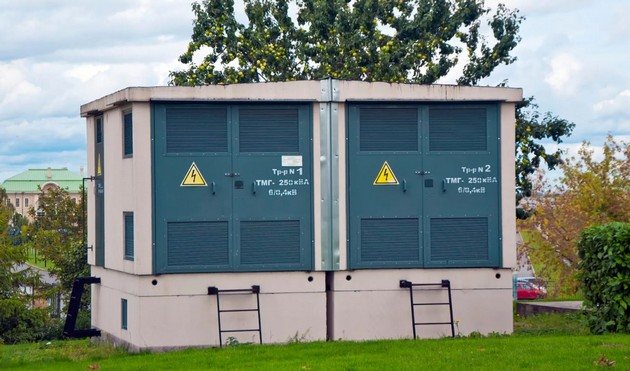

We already understand that for the appearance of these very parasitic currents, a potential difference is required. Let's imagine a typical transformer substation that uses the TN-C grounding system. With an isolated neutral, the grounding loops are interconnected by a neutral conductor, abbreviated as PEN.
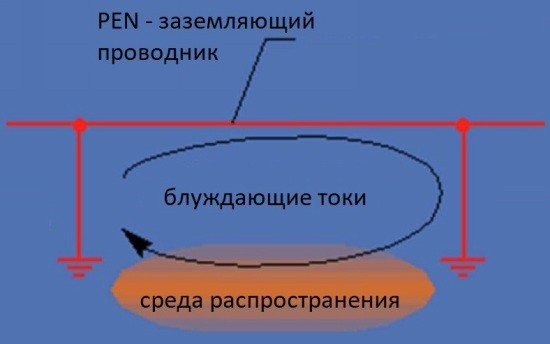

It turns out that the operating current of all consumers on the line flows through this conductor, with their simultaneous grounding. This line (PEN) has its own resistance, respectively, a voltage drop occurs at its different points.
PEN (aka grounding conductor) receives a banal potential difference between the nearest ground loops. An "unaccounted for" current appears, which, according to the principle described above, also flows through the physical earth, that is, in the ground. If a passing metal conductor appears in its path, the stray current behaves in the same way as in a pipe under a railroad bed. That is, in the anode zone it destroys the metal of the conductor (pipeline, reinforcement of reinforced concrete structures, cable sheath), and in the cathode zone destroys the PEN-conductor.
Insulation breakdown
The situation with the violation of the insulating sheath of the cable can occur anywhere. The question is what the consequences will be.
Suppose a phase leak into the ground at a considerable distance from the working ground loop. If the current strength is large enough (breakdown point of a large area), “favorable” conditions are created: wet soil, etc. - the protective automatics will work quickly enough, and the line will be turned off. And if the current strength is less than the cutoff current of the machine? Then between the "spot" of the leak and the "ground" long-running stray currents arise. And then you know: a passing pipeline, a cable in a metal sheath, anode zone, electrochemical corrosion ...
Actually, the risk group is defined:
- Pipelines with metal walls. It can be water, sewerage, oil or gas pipelines.
- Cable lines (power, signal, information) with a metal sheath.
- Metal reinforcement in road or building structures.
- Dimensional all-metal structures. For example, a container (tank) for storing petroleum products.
Grounding as protection against electrical corrosion
To prevent the occurrence of stray currents in the system and to protect the heated towel rail from electrochemical corrosion, it is necessary to recreate a stable connection between it and the riser pipe. In other words, you just need to ground the peripheral device by connecting the heated towel rail with a wire to a metal riser, or mount a potential equalization system.
It is also important to do this because some unscrupulous residents of apartment buildings, wanting to save money, put bugs on their electricity meters, and use heating or water supply pipelines as grounding. And then their neighbors are in real danger, because even a simple touch to a metal battery will give a person a "chance" to receive a fatal electric shock.
Remedies
The only way to prevent the appearance of stray currents is to remove the possibility of leakage from the conductors, which are the same rails, into the ground.For this, they arrange crushed stone embankments, install wooden sleepers, which are needed not only to obtain a solid foundation for the rail track, but also increase the resistance between it and the ground.
Additionally, the installation of gaskets made of dielectric materials is practiced. But all these methods are more suitable for railway lines, it is difficult to isolate tram tracks in this way, since this leads to an increase in the level of the rails, which is undesirable in urban conditions.
Also read: At what distance is it not dangerous to live next to a CHP
In the case of distribution points and substations, power lines, the situation can be corrected by using more advanced automatic shutdown systems. But the capabilities of such equipment are limited, and a constant power outage, especially in an industrial environment, is undesirable.
Therefore, in most cases, they resort to protecting pipelines, armored cables and metal structures located in the zone of action of stray currents.
Active and passive protection
There are two main ways to protect yourself:
- Passive - prevents metal contact through the use of coatings made of dielectric materials. It is for this purpose that coating with bituminous mastics, winding with dielectric insulating tapes, a combination of these methods are used. But such pipes are more expensive, and the problem is not completely solved, because with deep damage to such coatings, the protection practically does not work.

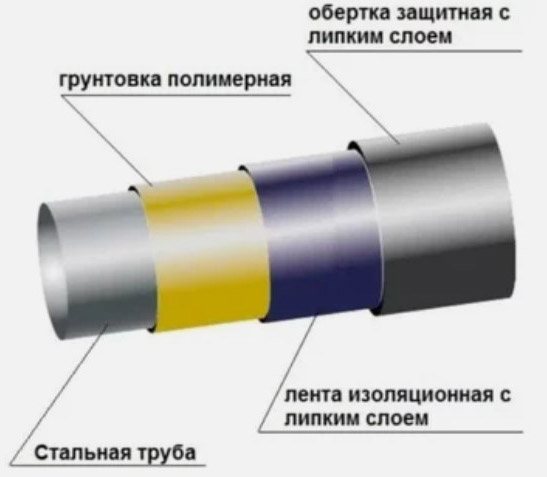
Passive defense - Active - based on the removal of stray currents from the protected highways. It can be done in several ways. It is considered the most effective solution.

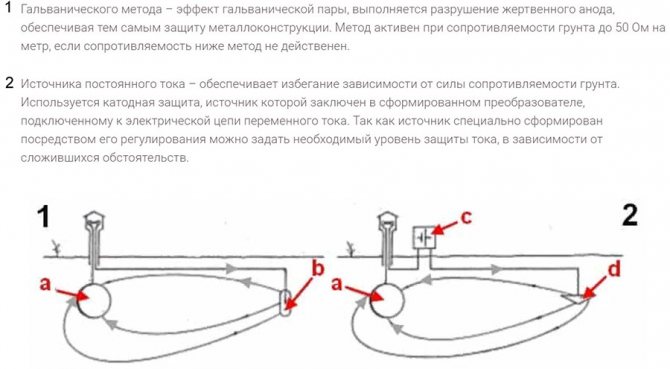
Active defense
In different conditions, different methods of protection against electrochemical corrosion are used. Let's take a look at a few basic examples.
Towel dryer protection
The main difference is that they are in the open air, so insulation will not help, and there is nowhere to divert stray currents. Therefore, the only valid option is potential equalization.
To solve this problem, a simple grounding is used. That is, they restore the conditions that were before the chain breaking with the help of polymer pipes. This requires grounding of each heated towel rail or heating radiator.
Protection of water pipes
In this case, protective protection with the use of an additional anode is more suitable. This method is also used to prevent the formation of scale in electric water heating tanks.
The anode, most often magnesium, is connected to the metal surface of the pipe, forming a galvanic pair. In this case, wandering currents go out not through steel, but through such a sacrificial anode, gradually destroying it. The metal pipe remains intact. It should be understood that replacement of the protective anode is required from time to time.
Protection of gas pipelines
Two methods are used to protect these objects:
- Cathodic protection, in which the pipe is given a negative potential due to the use of an additional power source.
- Electric drainage protection involves connecting the gas pipeline to the source of the problem with a conductor. This prevents the formation of a galvanic pair with the surrounding soil.
Note that the tangible damage to metal structures requires the use of complex measures. These include protecting and preventing hazards from occurring.
Polymer processing - the solution to the problem without grounding
But you can solve the problem in another way by treating the inner surface of a stainless steel water heated towel rail with a special polymer composition. It will create an insulating coating that will effectively “work” against potential differences and corrosion.
Polymer processing of water heated towel rails is an additional service that is performed by our company at the request of the buyer.And you can order it online on the ZIGZAG website.
Go to
Signs of electrical corrosion in a heated towel rail
Electrochemical corrosion on a water heated towel rail begins with the formation of small red spots, which gradually increase in size. Over time, the corrosion process becomes more intense. Rust spots not only expand, but also deepen into the metal, forming black dots on the outside and inside of the pipes. Under the influence of stray currents, the entire surface of the heated towel rail is damaged, and leaks appear on the welded seams, which only exacerbate the problem.
It should be added that rust has good "helpers". First of all, these are various impurities that are present in tap water. Chlorine, oxygen, magnesium and calcium salts have a negative effect on the metal and significantly accelerate the corrosion process. An important role in the deterioration of the condition of the heated towel rail is played by the high temperature of the water in the hot water supply (up to 70 degrees), which increases the onslaught of electrocorrosion.
Installation procedure for a water heated towel rail
Work order
It is quite possible to connect a water heated towel rail with your own hands.
If you want to know how to properly connect a heated towel rail, then it is best to follow this diagram:
- Dismantling the old heated towel rail
- Installation of cranes
- Installing a new heated towel rail
- Checking the quality of the installation
With the right approach, the entire procedure takes no more than a few hours. We will consider each of the above stages separately.
Dismantling the heated towel rail
Before connecting a water heated towel rail, you must remove the old one.
This is done as follows:
- We turn off the hot water supply to the pipe on which the heated towel rail is connected. This can be done by contacting the housing office, or independently (in agreement with the person in charge, for example, the chairman of the cooperative) by shutting off the corresponding valve.
- Heated towel rails with side connection, as well as any heated towel rails that are not an integral part of the hot water supply pipe, are dismantled by unscrewing the threaded connections.
- If the thread is "stuck", or the heated towel rail is simply welded to the pipe, we cut it off with a grinder.
Note! When dismantling a heated towel rail, trimming must be carried out in such a way that the pipe section is sufficient for threading.
We remove the dismantled heated towel rail from the brackets.
Installation of cranes
Next, you can proceed with the installation of cranes. If we cut off the old heated towel rail, we cut a new thread on the remains of the pipe with a die of the corresponding diameter. If the thread on the pipes remains, it should also be "driven out" to improve the quality of the threaded connection.
After bringing the thread in order, we install shut-off valves - taps.
This is done in order to:
- Adjust the intensity of the heated towel rail by opening or closing the taps
- If it was necessary to repair (for example, if a heated towel rail is leaking) or to replace a heated towel rail, it was possible to turn off the water and take the necessary actions.
Note!
If you plan to install a jumper - the so-called "bypass", you need to provide for its installation at this stage.
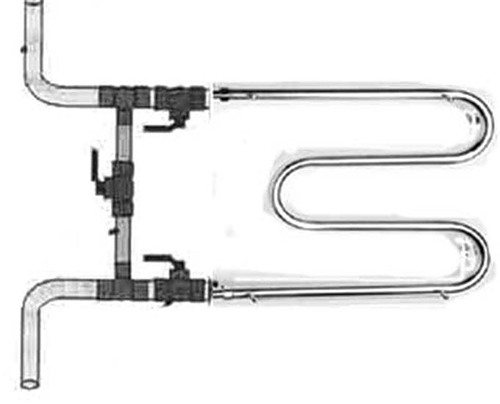

Connection diagram with "by-pass"
Installation of a heated towel rail
Depending on what type of connection the heated towel rail has, we choose fittings - straight or angled.
All threaded connections are sealed with linen winding. FUM tape is used for tapered threaded connections.
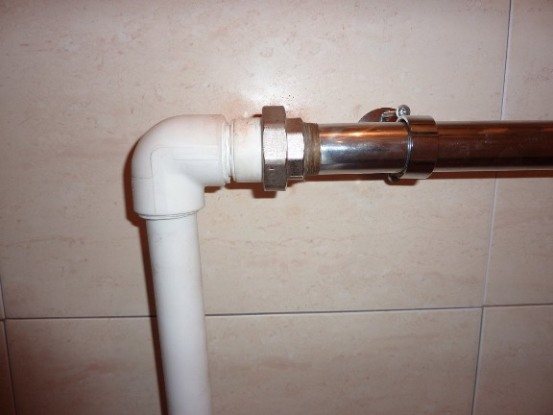

Connecting a heated towel rail to a pipe
We attach the heated towel rail to the fittings, tighten the fasteners, taking care not to damage the threads.
We attach the heated towel rail to the wall either with clamps or with the help of special telescopic holders.
Here it is important to choose the right distance from the wall (plaster or cladding) to the axis of the heated towel rail pipes:
- If the pipe diameter is less than 23 mm, the distance should be 35 mm or more
- If the pipe diameter is 40-50 mm, the minimum distance is 50 mm
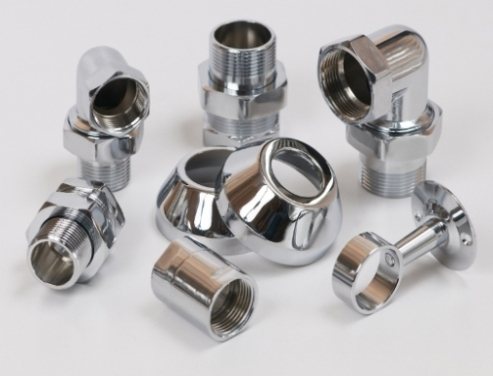

Fittings for connection
The connected heated towel rail must be checked for leaks by performing a test run. If everything is normal and there are no leaks, the device can be used.
Disadvantages of cathodic protection systems
The technique is by no means universal; it is necessary to build each object for specific operating conditions. In case of incorrect calculations of the protective current, the so-called "over-protection" occurs, and the cathode station is already a source of stray currents. Therefore, even after installation and commissioning, the cathode systems are constantly monitored. For this, special wells are mounted at different points to measure the protection current.
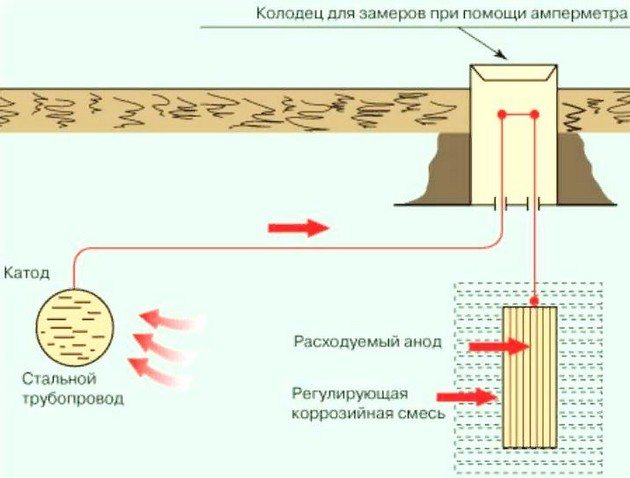

Control can be manual or automatic. In the latter case, a parameter tracking system is installed, connected to the control equipment of the cathode station.
Additional methods of protection against stray currents
- The use of cable lines with an outer sheath that is a good dielectric. For example, XLPE.
- When designing power supply systems, use only TN-S earthing systems. In case of major overhaul of networks, replace the outdated TN-C system.
- When calculating the routes of railways and underground communications, space these objects whenever possible.
- Use insulating embankments under the rails, made of materials with minimal electrical conductivity.

